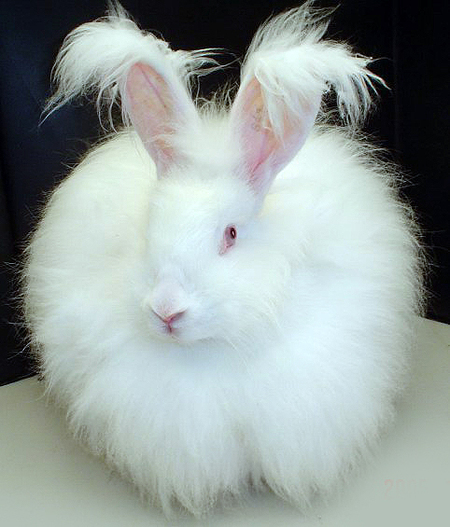
Angora rabbit
The Angora rabbit (Turkish: Ankara tavşanı), which is one of the oldest types[1] of domestic rabbit, is bred for the long fibers of its coat, known as Angora wool, which are gathered by shearing, combing or plucking. Because rabbits do not possess the same allergy-causing qualities as many other animals, [2] their wool is an important alternative. There are at least 11 distinct breeds of Angora rabbit, four of which are currently recognized by the American Rabbit Breeders Association (ARBA):[3] English Angora, French Angora, Giant Angora and Satin Angora. Others include German Angora, Chinese Angora, Finnish Angora, Japanese Angora, Korean Angora, Russian Angora, St Lucian Angora and Swiss Angora.
Country of origin
Worldwide
English, French, German, Giant, Satin, Chinese, Finnish, Japanese, Korean, Russian, St. Lucian, Swiss
Angora wool production, pet
- 2.0–5.5 kg (4.4–12.1 lb)
Long, Fine
White or Colored
Natural or Dyed
Albino ("Ruby-eyed White") or Colored
2–12
7–12 years
History[edit]
The Angora is said to have originated in Ankara (historically known as Angora), in present-day Turkey, and is known to have been brought to France in 1723. The Angora rabbit became a popular pet of the French royalty in the mid-18th century, and Angoras had spread to other parts of Europe by the end of that century.[1] In the United States, garments made of Angora-rabbit wool have been popular ever since they first arrived in the early 20th century. However, only during World War II did domestic production expand to meet the demand for more than 54,000 kg (120,000 lb) a year. This valuable, soft, silky, fiber aroused much interest, and quickly people became enamored with the production process.[4]
Genetics[edit]
Some genes or rather mutations causing the Angora phenotype have been identified. A gene that has been repeatedly found to be affected in Angora rabbits is the FGF5 gene. For example, a specific mutation (T19234C) changes the amino acid threonine (T) to cysteine (C) in the Fgf5 protein, causing the phenotype.[15]